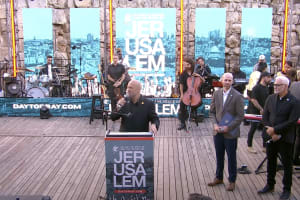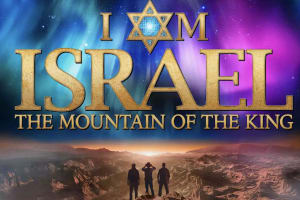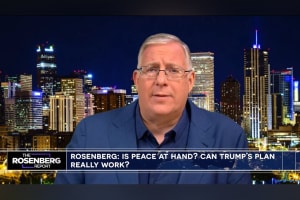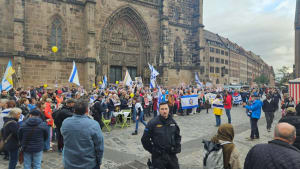Sukkot: God's prophetic blueprint for restoration

As the golden autumn sun casts long shadows and a slight chill returns to the evening air, a remarkable transformation sweeps across Israel. On balconies, in gardens, and atop apartment buildings, the sound of hammers and the rustle of palm fronds signal the arrival of the most joyous season in the Hebrew calendar: the Feast of Tabernacles, or Sukkot.
For seven days, the Jewish people will eat, sing, and even sleep in temporary booths, obeying the divine command: “You shall dwell in booths for seven days… that your generations may know that I made the people of Israel dwell in booths when I brought them out of the land of Egypt” (Leviticus 23:42-43, ESV).
But my friends, Sukkot is far more than a historical reenactment or a simple harvest festival. It is a living, breathing prophecy. It is God’s divine blueprint for the physical and spiritual restoration of His people—a prophetic enactment of the great and final Aliyah. From the wilderness wanderings to the modern-day miracle of the ingathering from the nations, Sukkot stands as an eternal memorial to God’s covenant faithfulness in bringing His children home.
I. Sukkot: A Feast of Ingathering and Return
The Lord ordained Sukkot as one of the three pilgrimage feasts (Exodus 23:14-17), a non-negotiable appointment with destiny for all Israel. Its name, “The Feast of Ingathering” (Exodus 23:16), holds a powerful double meaning. On one level, it celebrates the final harvest of the agricultural year. But prophetically, it points to the ultimate harvest of souls and the gathering of a people scattered to the four winds.
The agricultural symbolism is impossible to miss. Just as the farmer gathers his precious crops from the field to secure them in the storehouse, so too does the God of Israel promise to gather His people from the nations. The prophet Zechariah confirms this glorious vision: “I will whistle for them and gather them in, for I have redeemed them, and they shall be as many as they were before. Though I scattered them among the nations, yet in far countries they shall remember Me, and with their children they shall live and return” (Zechariah 10:8-9, ESV).
This is the heart of Sukkot: it is a feast of return. It commemorates a past redemption from Egypt, but its eyes are fixed firmly on the future—on the final redemption and the great ingathering of the exiles.
II. Historical Fulfillments: Sukkot and Israel’s Returns from Exile
The pages of Scripture reveal a profound pattern: every major return to the Land is marked by the observance of Sukkot. It is the feast of restoration.
When King Solomon dedicated the First Temple—the permanent dwelling place for God’s presence—he chose the time of Sukkot for the ceremony (1 Kings 8:2). The entire nation assembled, and the celebration was so immense it lasted fourteen days. This was no coincidence. The dedication during Sukkot foreshadowed a future restoration and God’s desire to dwell among a gathered people.
This pattern repeated itself after the Babylonian exile. The books of Ezra and Nehemiah record that the first thing the returning exiles did was rebuild the altar and immediately keep the Feast of Tabernacles. “And they kept the Feast of Booths, as it is written” (Ezra 3:4, ESV). Nehemiah 8:17 adds a stunning detail: the joy was so great, and the observance so thorough, that “all the returned exiles made booths… And there was very great rejoicing.” The text even notes that such a widespread, unified observance had not been seen since the days of Joshua. Sukkot was the first feast restored, signifying a new beginning—a national resurrection.
III. Prophetic Sukkot: The Final Aliyah and the Messianic Era
The prophetic vision for Sukkot expands to encompass all nations. The prophet Zechariah delivers a breathtaking picture of the Messianic Age, after the Lord has fought for Jerusalem and established His reign. He declares: “Then everyone who survives of all the nations… shall go up year after year to worship the King, the Lord of hosts, and to keep the Feast of Booths” (Zechariah 14:16, ESV).
Let us grasp the magnitude of this prophecy. First, it implies that the great Aliyah is complete. All of Israel will have been gathered from the nations. Second, the Gentile nations will stream to Jerusalem, not as conquerors, but as worshippers, acknowledging the God of Jacob as the one true King. Sukkotbecomes the universal feast of God’s kingship and protection.
This vision of ingathering and unity is echoed in Ezekiel’s powerful prophecy of the two sticks (Ezekiel 37:21-28). God promises to take the children of Israel from among the nations, bring them into their own land, and make them one nation. This reunification of Judah and the lost tribes of Israel under one king mirrors the unity and joy of Sukkot, when a secure and gathered Israel dwells in the presence of their God.
IV. Jesus (Yeshua) and the Fulfillment of Sukkot
The New Testament reveals how Jesus is the ultimate fulfillment of this feast. The Gospel of John opens with a profound Sukkot allusion: “The Word became flesh and dwelt among us” (John 1:14, ESV). The Greek word for “dwelt” is eskēnōsen, which literally means “to tabernacle” or “to pitch a tent.” Jesus’ incarnation was God “tabernacling” with His people once more. Many scholars believe His birth likely occurred during the season of Sukkot, making the connection even more powerful.
Furthermore, Jesus chose the climax of Sukkot—the day of the joyous Water Libation Ceremony—to stand in the Temple courts and declare: “If anyone thirsts, let him come to me and drink. Whoever believes in me, as the Scripture has said, ‘Out of his heart will flow rivers of living water’” (John 7:37-38, ESV). He was identifying Himself as the source of the living water that the ceremony symbolized, the true fulfillment of the feast’s hope and the one who would pour out the Holy Spirit. This points directly to the final redemption when, as Paul writes, “all Israel will be saved” (Romans 11:26).
V. Modern Aliyah: The Prophetic Sukkot Restoration in Our Day
We are living in the era of the great Sukkot ingathering. The prophetic whistle that Zechariah described is being heard in the farthest corners of the earth. Since the rebirth of the State of Israel in 1948, millions of Jews have returned from the four corners of the earth—from the ashes of Europe, the oppression of the Soviet Union, the mountains of Ethiopia, and the comforts of the West. This is a modern-day miracle, a tangible fulfillment of the ancient feast we celebrate.
The prophet Isaiah saw our day: “The Lord will extend His hand a second time to recover the remnant of His people… from the four corners of the earth” (Isaiah 11:11, ESV). Every flight from Kyiv, from Addis Ababa, from Mumbai, from Buenos Aires that lands at Ben Gurion Airport is a Sukkot flight. Every family that builds a new life in the land of their ancestors is building a prophetic sukkah—a testament to God’s enduring promise and protection.
Conclusion: A Living Prophecy
Therefore, Sukkot is not a relic of the past. It is a living, dynamic prophecy. It is the story of:
Israel’s physical return (Aliyah) from exile.
Spiritual revival through the Messiah, the true source of living water.
The coming Kingdom of God, where He will dwell with His redeemed people forever.
As we see the sukkahs dotting the landscape of Israel this week, let them remind us that we are witnessing the pages of prophecy turn in real time. Let us celebrate with great joy, but let our joy be active. Let us pray fervently for the completion of Aliyah, for the peace of Jerusalem, and for the soon return of the King of Kings, who will finally gather all His people into His presence.
Then, and only then, will the ancient greeting be fully realized: “Next year in Jerusalem—renewed, restored, and rejoicing!”
Chag Sukkot Sameach!

Aurthur is a technical journalist, SEO content writer, marketing strategist and freelance web developer. He holds a MBA from the University of Management and Technology in Arlington, VA.
You might also like to read this:

















